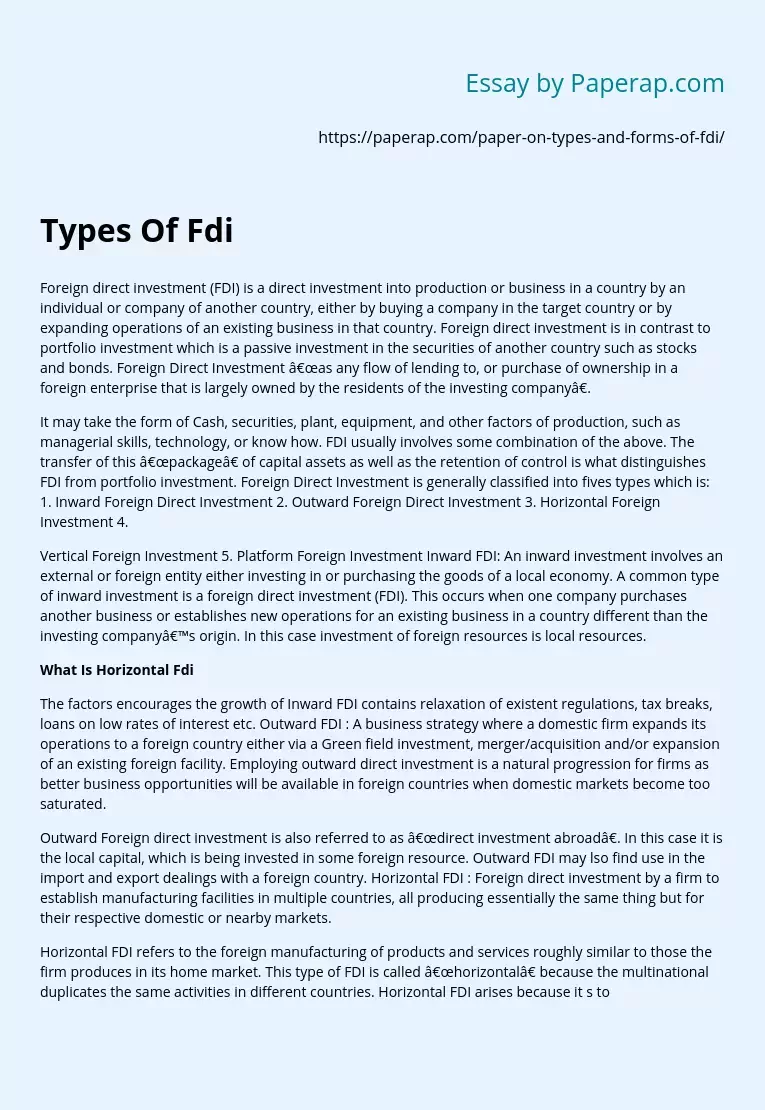Understanding FDI
Foreign direct investment (FDI) is a direct investment into production or business in a country by an individual or company of another country, either by buying a company in the target country or by expanding operations of an existing business in that country. Foreign direct investment is in contrast to portfolio investment which is a passive investment in the securities of another country such as stocks and bonds. Foreign Direct Investment “as any flow of lending to, or purchase of ownership in a foreign enterprise that is largely owned by the residents of the investing company”.
It may take the form of Cash, securities, plant, equipment, and other factors of production, such as managerial skills, technology, or know how. FDI usually involves some combination of the above. The transfer of this “package” of capital assets as well as the retention of control is what distinguishes FDI from portfolio investment. Foreign Direct Investment is generally classified into fives types which is: 1. Inward Foreign Direct Investment 2.
Outward Foreign Direct Investment 3. Horizontal Foreign Investment 4.
Vertical Foreign Investment 5. Platform Foreign Investment Inward FDI: An inward investment involves an external or foreign entity either investing in or purchasing the goods of a local economy. A common type of inward investment is a foreign direct investment (FDI). This occurs when one company purchases another business or establishes new operations for an existing business in a country different than the investing company’s origin. In this case investment of foreign resources is local resources.
What Is Horizontal Fdi
The factors encourages the growth of Inward FDI contains relaxation of existent regulations, tax breaks, loans on low rates of interest etc.
Outward FDI : A business strategy where a domestic firm expands its operations to a foreign country either via a Green field investment, merger/acquisition and/or expansion of an existing foreign facility. Employing outward direct investment is a natural progression for firms as better business opportunities will be available in foreign countries when domestic markets become too saturated.
Outward Foreign direct investment is also referred to as “direct investment abroad”. In this case it is the local capital, which is being invested in some foreign resource. Outward FDI may lso find use in the import and export dealings with a foreign country. Horizontal FDI : Foreign direct investment by a firm to establish manufacturing facilities in multiple countries, all producing essentially the same thing but for their respective domestic or nearby markets.
Horizontal FDI refers to the foreign manufacturing of products and services roughly similar to those the firm produces in its home market. This type of FDI is called “horizontal” because the multinational duplicates the same activities in different countries. Horizontal FDI arises because it s too costly to serve the foreign market by exports due to transportation costs or trade barriers. in multiple countries, each producing a different input to, or stage of, the firm’s production process. Vertical FDI refers to those multinationals that fragment production process geographically.
It is called because MNE separates the production chain vertically by outsourcing some production stages abroad. The basic idea behind the analysis of this type of FDI is that a production process consists of multiple stages with different input requirements. If input prices varies across ountries, it becomes profitable for the firm to split the production chain. Vertical FDI consists of two groups: backward and forward vertical FDI. In case of backward FDI multinational enterprise establishes its own supplier of input goods which delivers inputs to the parent company.
Conducting forward FDI, the firm builds up a foreign affiliate, which draws inputs from the parent company for own production, thus staying after the parent in the production chain. Platform FDI : Foreign direct investment from a source country into a destination country for the purpose of exporting to a third country. Horizontal FDI decreases international trade as the product of them is usually aimed at host country; the two other types generally act as a stimulus for it.
Green Field Investment direct investment in new facilities or the expansion of existing facilities. Greenfield investments are the primary target of a host nation’s promotional efforts because they create new production capacity and Jobs, transfer technology and know-how, and can lead to linkages to the global marketplace. However, it often does this by crowding out local industry; multinationals are able to produce goods more cheaply because of advanced technology and efficient processes) and uses up resources (labor, intermediate goods, etc).
Another downside of greenfield investment is that profits from production do not feed back into the local economy, but instead to the multinational’s home economy. This is in contrast to local industries whose profits flow back into the domestic economy to promote growth. Mergers And Acquisition occur when a transfer of existing assets from local firms to foreign firms takes place, this is the primary type of FDI. Cross-border mergers occur when the assets and operation of firms from different countries are combined to stablish a new legal entity.
Cross-border acquisitions occur when the control of assets and operations is transferred from a local to a foreign company, with the local company becoming an affiliate of the foreign company. Unlike greenfield investment, acquisitions provide no long term benefits to the local economy– even in most deals the owners of the local firm are paid in stock from the acquiring firm, meaning that the money from the sale could never reach the local economy. Nevertheless, mergers and acquisitions are a significant form of FDI and until around 1997, accounted for nearly 90% of the FDI flow into the United States.
Understanding FDI. (2019, Dec 05). Retrieved from https://paperap.com/paper-on-types-and-forms-of-fdi/

